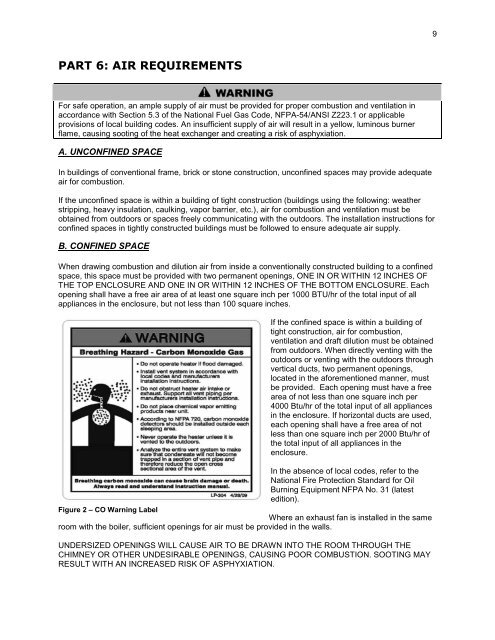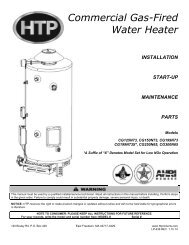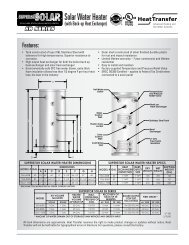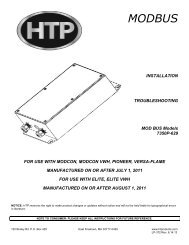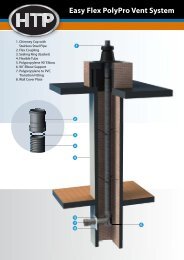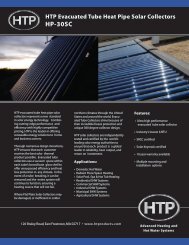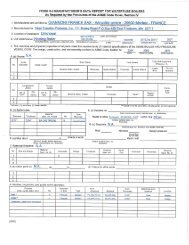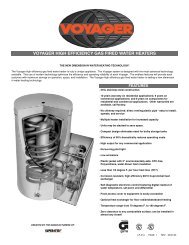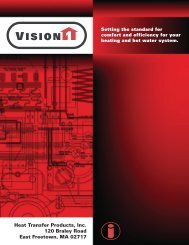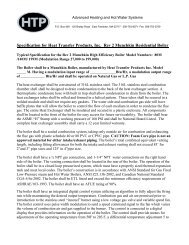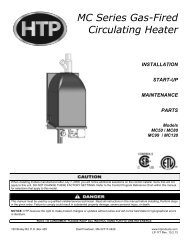SuperStor Oil Fired Water Heater
SuperStor Oil Fired Water Heater
SuperStor Oil Fired Water Heater
You also want an ePaper? Increase the reach of your titles
YUMPU automatically turns print PDFs into web optimized ePapers that Google loves.
9<br />
PART 6: AIR REQUIREMENTS<br />
For safe operation, an ample supply of air must be provided for proper combustion and ventilation in<br />
accordance with Section 5.3 of the National Fuel Gas Code, NFPA-54/ANSI Z223.1 or applicable<br />
provisions of local building codes. An insufficient supply of air will result in a yellow, luminous burner<br />
flame, causing sooting of the heat exchanger and creating a risk of asphyxiation.<br />
A. UNCONFINED SPACE<br />
In buildings of conventional frame, brick or stone construction, unconfined spaces may provide adequate<br />
air for combustion.<br />
If the unconfined space is within a building of tight construction (buildings using the following: weather<br />
stripping, heavy insulation, caulking, vapor barrier, etc.), air for combustion and ventilation must be<br />
obtained from outdoors or spaces freely communicating with the outdoors. The installation instructions for<br />
confined spaces in tightly constructed buildings must be followed to ensure adequate air supply.<br />
B. CONFINED SPACE<br />
When drawing combustion and dilution air from inside a conventionally constructed building to a confined<br />
space, this space must be provided with two permanent openings, ONE IN OR WITHIN 12 INCHES OF<br />
THE TOP ENCLOSURE AND ONE IN OR WITHIN 12 INCHES OF THE BOTTOM ENCLOSURE. Each<br />
opening shall have a free air area of at least one square inch per 1000 BTU/hr of the total input of all<br />
appliances in the enclosure, but not less than 100 square inches.<br />
If the confined space is within a building of<br />
tight construction, air for combustion,<br />
ventilation and draft dilution must be obtained<br />
from outdoors. When directly venting with the<br />
outdoors or venting with the outdoors through<br />
vertical ducts, two permanent openings,<br />
located in the aforementioned manner, must<br />
be provided. Each opening must have a free<br />
area of not less than one square inch per<br />
4000 Btu/hr of the total input of all appliances<br />
in the enclosure. If horizontal ducts are used,<br />
each opening shall have a free area of not<br />
less than one square inch per 2000 Btu/hr of<br />
the total input of all appliances in the<br />
enclosure.<br />
In the absence of local codes, refer to the<br />
National Fire Protection Standard for <strong>Oil</strong><br />
Burning Equipment NFPA No. 31 (latest<br />
edition).<br />
Figure 2 – CO Warning Label<br />
Where an exhaust fan is installed in the same<br />
room with the boiler, sufficient openings for air must be provided in the walls.<br />
UNDERSIZED OPENINGS WILL CAUSE AIR TO BE DRAWN INTO THE ROOM THROUGH THE<br />
CHIMNEY OR OTHER UNDESIRABLE OPENINGS, CAUSING POOR COMBUSTION. SOOTING MAY<br />
RESULT WITH AN INCREASED RISK OF ASPHYXIATION.


